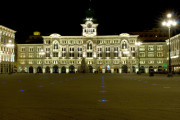
Trieste (Italian: Trieste; Slovene and Croatian: Trst; German: Triest) is a city and port in northeastern Italy very near to the Slovenian border, to the North, East and South. Trieste is located at the head of the Gulf of Trieste on the Adriatic Sea.
By 177 BC, the city was under the rule of the Roman republic. Trieste was granted the status of colony under Julius Caesar, who recorded its name as Tergeste.
Trieste flourished as part of Austria, from 1382 (the Austro-Hungarian Empire from 1867) until 1918 when it was one of the few seaports in what was one of the Great Powers of Europe. It was among the most prosperous Mediterranean seaports as well as a capital of literature and music. However, the collapse of the Austro-Hungarian Empire and Trieste's annexation to Italy after World War I led to a decline of its economic and cultural importance.
Today, Trieste is a border town. The population is an ethnic mix of the neighbouring regions; The dominant local Venetian dialect of Trieste is called Triestine (in Italian "Triestino"). This dialect and the official Italian language are spoken in the city centre, while Slovene is spoken in several of the immediate suburbs. The Venetian and the Slovene languages are considered autochthonous of the area. There are also small numbers of German and Hungarian speakers.
Places of touristic interest in Trieste include numerous examples of Art Nouveau and neoclassical architecture from its Austrian past, the International Centre for Theoretical Physics, the International School for Advanced Studies and Trieste University.